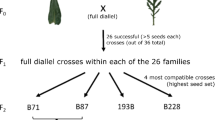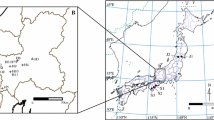Abstract
Turnera sidoides is a complex of outcrossing, perennial, rhizomatous herbs that is widely distributed in southern South America. Five subspecies are recognized taxonomically based on morphological features and geographical distribution. In certain regions, the areas of distribution of the subspecies overlap partially. In such contact zones, the extent of reproductive barriers among subspecies is still largely unknown, but morphologically intermediate individuals have been found in the field, indicating that hybridization may actually occur between subspecies. Crossability among subspecies of T. sidoides has been shown by experimental studies with cultivated plants, but the mechanisms involved in natural populations are still unknown. To investigate the mechanisms that underlie gene flow within the T. sidoides complex, in this paper we analyze the morphological and genetic variation, as well as the crossability among taxa in a contact zone between subspecies pinnatifida and sidoides, in southeastern Uruguay. Our results constitute the first evidences of ongoing natural hybridization between subspecies of T. sidoides and suggest that, although hybridization may not have been of significance in the early phase of the species differentiation, reticulate evolution is ongoing enhancing the current morphological and genetic variability of the complex.






Similar content being viewed by others
References
Arbo MM (1985) Notas taxonómicas sobre Turneráceas Sudamericanas. Candollea 40:175–191
Arnold ML (1997) Natural hybridization and evolution. Oxford University Press, Oxford
Avise JC (2004) Molecular markers, natural history, and evolution, 2nd edn. Sinauer, Sunderland
Barton NH, Hewitt GM (1985) Analysis of hybrid zones. Annual Rev Ecol Syst 16:113–148
Bowen CC (1956) Freezing by liquid carbon dioxide in making slides permanent. Stain Technol 31:87–90
Bretagnolle F, Thompson JD (1995) Gametes with the somatic chromosome number: mechanisms of their formation and role in the evolution of autopolyploid plants. New Phytol 129:1–22
Cullings KW (1992) Design and testing of a plant-specific PCR primer for ecological and evolutionary studies. Mol Ecol 1:233–240
Doyle JJ, Doyle JL (1987) A rapid DNA isolation procedure for small quantities of fresh leaf tissue. Phytochem Bull 19:11–15
Elías G (2010) Dinámica de una zona de contacto diploide-tetraploide de Turnera sidoides subsp. pinnatifida (Turneraceae). Doctoral Thesis, Universidad Nacional de Tucumán (Argentina)
Elías G, Sartor M, Solís Neffa VG (2011) Patterns of cytotype variation of Turnera sidoides subsp. pinnatifida (Turneraceae) in mountain ranges of central Argentina. J Pl Res 124:25–34
Excoffier L, Smouse PE, Quattro JM (1992) Analysis of molecular variance inferred from metric distances among DNA haplotypes: application to human mitochondrial DNA restriction data. Genetics 131:479–494
Falush D, Stephens M, Pritchard JK (2003) Inference of population structure using multilocus genotype data: linked loci and correlated allele frequencies. Genetics 164:1567–1587
Felber F, Bever JD (1997) Effect of triploid fitness on the coexistence of diploids and tetraploids. Biol J Linn Soc 60:95–106
Fernández A (1973) El ácido láctico como fijador cromosómico. Bol Soc Argent Bot 15:287–290
Fernández A (1987) Estudios cromosómicos en Turnera y Piriqueta (Turneraceae). Bonplandia 6:1–21
Fernández A, Arbo MM (1989) Relaciones genómicas entre cuatro especies diploides de Turnera con flores amarillas (Serie Canaligerae). Bonplandia 6:93–109
Fernández A, Solís Neffa VG (2004) Genomic relationships between Turnera krapovickasii (2x, 4x) and T. ulmifolia (6x) (Turneraceae, Turnera). Caryologia 57:45–51
Fernández A, Rey H, Solís Neffa VG (2010) Evolutionary relationships between the diploid Turnera grandiflora and the octoploid T. fernandezii (Series Turnera, Turneraceae). Ann Bot Fenn 47:321–329
Grant V (1981) Plant speciation, 2nd edn. Columbia University Press, New York
Grant BR, Grant PR (1996) High survival of Darwin’s finch hybrids: effects of beak morphology and diets. Ecology 77:500–509
Harrison RG (1990) Hybrids zones: windows on evolutionary process. Oxford Surv Evol Biol 7:69–128
InfoStat (2012) InfoStat, versión 2012. Manual del Usuario. Grupo InfoStat, FCA, Universidad Nacional de Córdoba. Primera Edición, Editorial Brujas Argentina
Kovalski IE (2013) Origen y establecimiento de poliploides en poblaciones naturales de Turnera sidoides. Doctoral Thesis, Universidad Nacional de Córdoba (Argentina)
Kovalski IE, Roggero Luque JM, Solís Neffa VG (2011) Estudios citogenéticos en triploides del complejo Turnera sidoides. BAG XL (Suplemento): 124
Kovalsky IE, Solís Neffa VG (2012) Evidence of 2n microspore production in a natural diploid population of Turnera sidoides subsp. carnea and its relevance in the evolution of the T. sidoides (Turneraceae) autopolyploid complex. J Pl Res 125:725–734
Levin DA (1975) Minority cytotype exclusion in local plants populations. Taxon 24:35–43
Lynch M, Milligan BG (1994) Analysis of population structure with RAPD markers. Mol Ecol 3:91–99
McCauley DE (1995) The use of chloroplast DNA polymorphism in studies of gene flow in plants. Trends Ecol Evol 10:198–202
Nason JD, Ellstrand NC, Arnold ML (1992) Patterns of hybridization and introgression in populations of oaks, manzanitas, and irises. Amer J Bot 79:101–111
Ouborg NJ, Piquot Y, Van Groenendael JM (1999) Population genetics, molecular markers and the study of dispersal in plants. J Ecol 87:551–568
Panseri AF, Seijo JG, Solís Neffa VG (2008) Análisis de la producción y frecuencia de microsporas no reducidas en diploides de Turnera sidoides (Turneraceae). Bol Soc Argent Bot 43:95–101
Peakall R, Smouse PE (2006) GENALEX 6: genetic Analysis in Excel. Population genetic software for teaching and research. Mol Ecol Notes 6:288–295
Pritchard JK, Stephens M, Donnelly P (2000) Inference of population structure using multilocus genotype data. Genetics 155:945–959
Ramsey J, Schemske DW (1998) Pathways, mechanisms, and rates of polyploid formation in flowering plants. Annual Rev Ecol Syst 29:467–501
Rieseberg LH (1997) Hybrid origins of plant species. Annual Rev Ecol Syst 28:359–389
Rieseberg LH, Carney SH (1998) Plant hybridization. New Phytol 140:599–624
Rieseberg LH, Ellstrand NC (1993) What can morphological and molecular markers tell us about plant hybridization? Crit Rev Pl Sci 12:213–241
Rieseberg LH, Wendel JF (1993) Introgression and its consequences in plants. In: Harrison RG (ed) Hybrid zones and the evolutionary process. Oxford University Press, Oxford, pp 71–109
Rieseberg LH, Baird SJE, Gardner KA (2000) Hybridization, introgression, and linkage evolution. Pl Mol Biol 42:205–224
Savidan Y, Pernès J (1981) Diploid-tetraploid-dihaploid cycles in the evolution of Panicum maximum Jacq. Evolution 36:596–600
Shaw J, Lickey EB, Beck JT, Farmer SS, Liu W, Miller J, Siripun KC, Winder CT, Schilling EE, Small RL (2004) The tortoise and the hare II: relative utility of 21 noncoding chloroplast DNA sequences for phylogenetic analyses. Amer J Bot 92:142–166
Shore JS, Barrett SCH (1985) Morphological differentiation and crossability among populations of the Turnera ulmifolia L. complex (Turneraceae). Syst Bot 10:308–321
Solís Neffa VG (2000) Estudios biosistemáticos en el complejo Turnera sidoides L. (Turneraceae, Leiocarpae). Doctoral Thesis, Universidad Nacional de Córdoba (Argentina)
Solís Neffa VG (2010) Geographic patterns of morphological variation in Turnera sidoides L. subsp. pinnatifida (Turneraceae). Pl Syst Evol 284:219–229
Solís Neffa VG, Fernández A (2001) Cytogeography of the Turnera sidoides L. complex (Turneraceae, Leiocarpae). Bot J Linn Soc 137:189–196
Solís Neffa VG, Panseri AF, Reynoso W, Seijo JG (2004) Variación del color de flores y números cromosómicos en el noroeste del área de distribución de Turnera sidoides (Turneraceae). Bonplandia 13:117–128
Solís Neffa VG, Panseri AF, Kovalsky IE, Fernández A (2008) Estudios citogenéticos en híbridos artificiales del complejo Turnera sidoides. BAG XIX (Suplemento): 195–196
Speranza PR, Seijo JG, Grela IA, Solís Neffa VG (2007) cpDNA variation in the Turnera sidoides L. complex (Turneraceae): biogeographical implications. J Biogeogr 34:427–436
Stebbins GL (1950) Variation and evolution in plants. Columbia University Press, New York
Stebbins GL (1959) The role of hybridization in evolution. Proc Amer Philos Soc 103:231–251
Stebbins GL (1971) Chromosomal evolution in higher plants. E. Arnold, London
Stift M, Bregman R, Gerard J, Oostermeijer B, van Tienderen PH (2010) Other tetraploid species and conspecific diploids as sources of genetic variation for an autotetraploid. Amer J Bot 97:1858–1866
Taberlet P, Gielly L, Pautou G, Bouvet J (1991) Universal primers for amplification of three non-coding regions of chloroplast DNA. Pl Mol Biol 17:1105–1109
Zohary D, Nur U (1959) Natural triploids in the orchard grass, Dactylis glomerata L., polyploid complex and their significance for gene flow from diploid to tetraploid levels. Evolution 13:311–317
Acknowledgments
This research was partially supported by grants of Agencia Nacional de Promoción Científica, Tecnológica y de Innovación (ANPCyT- FONCyT, PICT 14674 and 01-1329; PICTO 07-90), National Research Council of Argentina (CONICET, PIP 5998) and Secretaría General de Ciencia y Técnica (UNNE, PI-013/04 and PI-014/07). E.M.S. Moreno and J.M. Roggero Luque are Doctoral Fellows of CONICET, and V.G. Solís Neffa is a member of the Carrera del Investigador Científico of CONICET.
Author information
Authors and Affiliations
Corresponding author
Electronic supplementary material
Below is the link to the electronic supplementary material.
Rights and permissions
About this article
Cite this article
Moreno, E.M.S., Speranza, P.R., Roggero Luque, J.M. et al. Natural hybridization among subspecies of Turnera sidoides L. (Passifloraceae) revealed by morphological and genetic evidence. Plant Syst Evol 301, 883–892 (2015). https://doi.org/10.1007/s00606-014-1122-9
Received:
Accepted:
Published:
Issue Date:
DOI: https://doi.org/10.1007/s00606-014-1122-9




